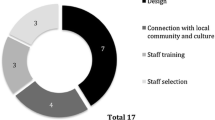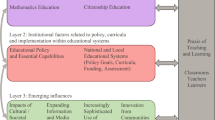Abstract
In this article we proffer a theoretical model for analyzing power in language policy processes and incorporate ethnographic data to illustrate the usefulness of the model. Grounded in an ethnographic project in the US state of Washington, we examine how nominally identical school district-level programs, which are funded under the same state-level language policy, end up being different in practice. While language policy is often portrayed as multiply layered, or taking place across multiple levels of policy activity, we argue that language policy arbiters wield a disproportionate amount of power relative to other individuals in a particular level or layer. Our analysis focuses on how beliefs about language, language education, and educational research impact the decision-making of individuals we identify as language policy arbiters. We argue that the proposed model usefully highlights how language policy arbiters open and close spaces for additive bilingual education.
Similar content being viewed by others
References
Ball, S. J. (2006). Education policy and social class. New York, NY: Routledge.
Chick, K. (2001). Constructing a multicultural national identity: South African classrooms as sites of struggle between competing discourses. Working Papers in Educational Linguistics, 17(1&2), 2745.
Chimbutane, F. (2011). Rethinking bilingual education in postcolonial contexts. Clevedon, UK: Multilingual Matters.
Cincotta-Segi, A. (2009). ‘The big ones swallow the small ones.’ Or do they? The language policy and practice of ethnic minority education in the Lao PDR: A case study from Nalae. Ph.D. thesis, The Australian National University, Canberra.
Cincotta-Segi, A. (2011). Talking in, talking around and talking about the L2: Three literacy teaching responses to L2 medium of instruction in the Lao PDR. Compare, 41(2), 195–209.
Crawford, J. (2004). Educating English learners. Los Angeles, CA: Bilingual Education Services.
Davis, K. A. (1999). The sociopolitical dynamics of indigenous language maintenance and loss: A framework for language policy and planning. In T. Huebner & K. A. Davis (Eds.), Sociopolitical perspectives on language policy and planning in the USA (pp. 67–97). Amsterdam/Philadelphia: John Benjamins.
Davies, H. T. O., & Nutley, S. M. (2008). Learning more about how research-based knowledge gets used: Guidance in the development of new empirical research. New York: William T. Grant Foundation.
Foucault, M. (1991). Governmentality. In G. Burchell, C. Gordon, & P. Miller (Eds.), The Foucault effect: Studies in governmentality (pp. 87–104). Chicago, IL: The University of Chicago Press.
Freeman, R. D. (2000). Contextual challenges to dual-language education: A case study of a developing middle school program. Anthropology & Education Quarterly, 31(2), 202–229.
Freeman, R. (2004). Building on community bilingualism. Philadelphia: Caslon Publishing.
Gándara, P., & Hopkins, M. (2010). Forbidden language: English learners and restrictive language policies. New York, NY: Teachers College Press.
Hart, B., & Risley, T. R. (1995). Meaningful differences in the everyday experiences of young American children. Baltimore, MD: Brookes.
Hornberger, N. H. (1991). Extending enrichment bilingual education: Revisiting typologies and redirecting policy. In O. García (Ed.), Bilingual education: Focusschrift in honor of Joshua A. Fishman (Vol. 1, pp. 215–234). Philadelphia: John Benjamins.
Hornberger, N. H. (2002). Multilingual language policies and the continua of biliteracy: An ecological approach. Language Policy, 1(1), 27–51.
Hornberger, N. H. (2009). Multilingual education policy and practice: Ten certainties (grounded in indigenous experience). Language Teaching, 42(2), 197–211.
Hornberger, N. H., & Johnson, D. C. (2007). Slicing the onion ethnographically: Layers and spaces in multilingual language education policy and practice. TESOL Quarterly, 14(3), 509–532.
Hornberger, N. H., & Johnson, D. C. (2011). The ethnography of language policy. In T. L. McCarty (Ed.), Ethnography and language policy (pp. 273–289). New York and London: Routledge.
Hult, F. M. (Ed.). (2010). Directions and prospects for educational linguistics. Dordrecht, Netherlands: Springer.
Hymes, D. (1964). Introduction: Toward ethnographies of communication. American Anthropologist, 66(6), 1–35.
Johnson, E. J. (2009). (Re)defining freedom of speech: Language policy, education, and linguistic rights in the United States. Journal of Applied Language Studies, 3(1), 2–23.
Johnson, D. C. (2010). Implementational and ideological spaces in bilingual education language policy. International Journal of Bilingual Education and Bilingualism, 13(1), 61–79.
Johnson, D. C. (2013a). Language policy. Basingstoke, UK: Palgrave Macmillan.
Johnson, D. C. (2013b). Positioning the language policy arbiter: Governmentality and footing in The School District of Philadelphia. In J. W. Tollefson (Ed.), Language policies in education: Critical issues (pp. 116–136). New York and London: Routledge.
Johnson, D. C. (Ed.) (2013c). Thematic issue ‘Ethnography of language policy: Theory, method, and practice.’ International Journal of the Sociology of Language, 219, 1–160.
Johnson, D. C., & Freeman, R. (2010). Appropriating language policy on the local level: Working the spaces for bilingual education. In K. Menken & O. Garcia (Eds.), Negotiating language policies in schools: Educators as policymakers (pp. 13–31). New York and London: Routledge.
Johnson, E. J., & Johnson, D. C. (2014). Language policy in Arizona and Washington State. International Journal of Bilingual Education and Bilingualism,. doi:10.1080/13670050.2014.882288.
Labov, W. (1972). Language in the inner city: Studies in the black English vernacular. Philadelphia: University of Pennsylvania Press.
Levinson, B. A. U., & Sutton, M. (2001). Introduction: Policy as/in practice—A sociocultural approach to the study of educational policy. In M. Sutton & B. Levinson (Eds.), Policy as practice: Toward a comparative sociocultural analysis of educational policy (pp. 1–19). Westport, CT: Ablex.
Levinson, B. A. U., Sutton, M., & Winstead, T. (2007). Education policy as a practice of power: Ethnographic methods, democratic options. Paper presented at the 28th annual ethnography in education research forum, Philadelphia, PA.
Levinson, B. A. U., Sutton, M., & Winstead, T. (2009). Education policy as a practice of power: Theoretical tools, ethnographic methods, democratic options. Educational Policy, 23(6), 767–795.
Lindholm-Leary, K. J. (2001). Dual language education. Buffalo, NY: Multilingual Matters.
Madison, D. S. (2012). Critical ethnography: Method, ethics, and performance. Los Angeles: Sage Publications.
Malagon, H., & Chacon, A. (2009). Washington state transitional bilingual instruction program guidelines. Report prepared for: Special programs and Federal Accountability, Office of Superintendent of Public Instruction, Migrant and Bilingual Education. www.k12.wa.us/migrantbilingual/pubdocs/TBIPProgramGuidelines.pdf.
Martin-Jones, M., & Romaine, S. (1986). Semilingualism: A half-baked theory of communicative competence. Applied Linguistics, 7(1), 26–38.
May, S. (Ed.) (2005). Thematic issue ‘Bilingual/immersion education in Aotearoa/New Zeland.’ The International Journal of Bilingual Education and Bilingualism, 8(5), 365–503.
McCarty, T. L. (2011a). Ethnography and language policy. New York and London: Routledge.
McCarty, T. L. (2011b). Introducing ethnography and language policy. In T. L. McCarty (Ed.), Ethnography and language policy (pp. 1–28). New York, NY: Routledge.
Menken, K. (2008). English learners left behind: Standardized testing as language policy. Clevedon, UK: Multilingual Matters.
Menken, K., & García, O. (Eds.). (2010). Negotiating language policies in schools: Educators as policymakers. New York, NY: Routledge.
Menken, K., & Shohamy, E. (2008). No child left behind and U.S. language education policy (special issue). Language Policy, 7(3), 191–307.
Office of Superintendent of Public Instruction. (2012). Educating English language learners in Washington 2011–2012. Report to the legislature. http://www.k12.wa.us/MigrantBilingual/BilingualProgram.aspx.
Ovando, C. (2003). Bilingual education in the United States: Historical development and current issues. Bilingual Research Journal, 27(1), 1–24.
Palmer, D. K. (2009). Middle-class English speakers in a two-way immersion bilingual classroom: “Everybody should be listening to Jonathan right now…”. TESOL Quarterly, 43(2), 177–202.
Pan, L. (2011). English language ideologies in the Chinese foreign language education policies: A world-system perspective. Language Policy, 10(3), 245–263.
Pennycook, A. (2002). Language policy and docile bodies: Hong Kong and governmentality. In J. W. Tollefson (Ed.), Language policies in education: Critical issues (pp. 91–110). Mahwah, NJ: Lawrence Erlbaum Associates.
Ricento, T. (2006). Language policy: Theory and practice—an introduction. In T. Ricento (Ed.), An introduction to language policy: Theory and method (pp. 10–23). Malden, MA: Blackwell.
Ricento, T. K., & Hornberger, N. H. (1996). Unpeeling the onion: Language planning and policy and the ELT professional. TESOL Quarterly, 30(3), 401–427.
Ruiz, R. (1984). Orientations in language planning. NABE Journal, 8(2), 15–34.
Schiffman, H. F. (1996). Linguistic culture and language policy. London, UK: Routledge.
Shin, S. (2013). Bilingualism in schools and society: Language, identity, and policy. New York: Taylor and Francis.
Shohamy, E. (2006). Language policy: Hidden agendas and new approaches. London and New York: Routledge.
Stritikus, T. (2002). Immigrant children and the politics of English-only. New York: LFB Scholarly.
Stritikus, T., & Wiese, A. M. (2006). Reassessing the role of ethnographic methods in education policy research: Implementing bilingual education policy at local levels. Teachers College Record, 108, 1106–1131.
Thomas, W., & Collier, V. (1997). School effectiveness for language minority students. Washington, DC: National Clearinghouse for Bilingual Education.
Tollefson, J. W. (1991). Planning language, planning inequality. London and New York: Longman.
Tollefson, J. W. (2006). Critical theory in language policy. In T. Ricento (Ed.), An introduction to language policy: Theory and method (pp. 42–59). Oxford: Blackwell.
Tollefson, J. W. (Ed.). (2013a). Language policies in education: Critical issues. Mahwah, NJ: Lawrence Erlbaum Associates.
Tollefson, J. W. (2013b). Language policy in a time of crisis and transformation. In J. Tollefson (Ed.), Language policies in education: Critical issues (pp. 3–15). Mahwah, NJ: Lawrence Erlbaum Associates.
United States Census. (2014). State and county quick facts: Washington. http://quickfacts.census.gov/qfd/states/53000.html.
Warhol, L. (2011). Native American language education as policy-in-practice: An interpretive policy analysis of the Native American Languages Act of 1990/1992. International Journal of Bilingual Education and Bilingualism, 14(3), 279–299.
Wiley, T. G. (1996). Language planning and policy. In S. L. McKay & N. H. Hornberger (Eds.), Sociolinguistics and language teaching (pp. 103–147). Cambridge, UK: Cambridge University Press.
Wiley, T. G., & Wright, W. E. (2004). Against the undertow: The politics of language instruction in the United States. Educational Policy, 18(1), 142–168.
Wodak, R., & Fairclough, N. (2010). Recontextualizing European higher education policies: The cases of Austria and Romania. Critical Discourse Studies, 7(1), 19–40.
Wortham, S., Murillo, E. G., & Hamann, E. T. (2002). Education in the new Latino diaspora: Policy and the politics of identity. Westport, CT: Ablex.
Author information
Authors and Affiliations
Corresponding author
Rights and permissions
About this article
Cite this article
Johnson, D.C., Johnson, E.J. Power and agency in language policy appropriation. Lang Policy 14, 221–243 (2015). https://doi.org/10.1007/s10993-014-9333-z
Received:
Accepted:
Published:
Issue Date:
DOI: https://doi.org/10.1007/s10993-014-9333-z




